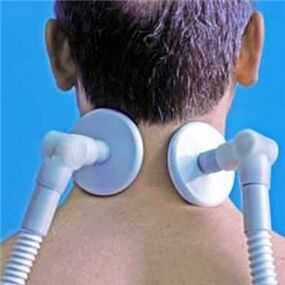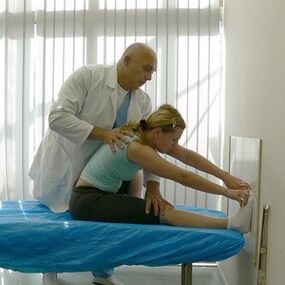Among the many known diseases, the most numerous diseases of the musculoskeletal system are common, which are mainly related to physical inactivity. In addition, such problems occur not only in the elderly, but also in young people. Osteochondrosis of the cervical spine occupies a special place among the pathologies affecting the musculoskeletal system. What is this disease? What threatens the owner? How does he manifest himself? Are prevention and treatment measures effective?
diseases of the musculoskeletal system are common, which are mainly related to physical inactivity. In addition, such problems occur not only in the elderly, but also in young people. Osteochondrosis of the cervical spine occupies a special place among the pathologies affecting the musculoskeletal system. What is this disease? What threatens the owner? How does he manifest himself? Are prevention and treatment measures effective?
Cervical osteochondrosis is a progressive degenerative-dystrophic disease, accompanied by deformation of the intervertebral disc. It requires immediate treatment to prevent irreversible pathological changes. Among the various forms of osteochondrosis, cervical pathology ranks second, second only to damage to the lumbosacral region.
The stage of the disease
The development of cervical osteochondrosis occurs in stages:
- First stage. The intervertebral disc begins to collapse: cracks appear in the annulus fibrosus, the disc loses its strength and elasticity, and becomes smaller. As a result, the nerve roots are compressed, which is accompanied by pain.
- The second level. Disc destruction continues, resulting in dislocation of the small vertebrae. The sensation of pain increases and becomes permanent. Falling head syndrome may occur, which is characterized by severe pain that forces the head to be held in a fixed position.
- The third level. The fibrous annulus is almost completely destroyed, leading to protrusion and intervertebral hernia. In this case, the pain can be reduced, because there is no source of pain - cartilage tissue. But the pain syndrome is not completely gone, because the nerve roots remain pinched. Possible violation of sensitivity, the appearance of headache and dizziness, nausea, "lumbago" in the neck.
In the first stage, the disease is successfully cured. In the second and third stages, irreversible changes occur. Therefore, it is not possible to fully recover the body.
Causes of pathological changes

The vertebrae located in the cervical spine are the easiest to move. They are small in size and have weak muscles. This vertebral structure contributes to the development of degenerative disorders. In addition, the cervical area is filled with nerves and blood vessels, damage that not only causes unpleasant symptoms, but also causes serious complications.
Major factors leading to the development of cervical osteochondrosis include:
- inactive lifestyle;
- prolonged stay in the same position;
- metabolic disorders;
- salt deposits;
- poor nutrition.
The risk of developing the disease increases with:
- hereditary tendencies;
- aged;
- neck injuries;
- prolonged or periodic body hypothermia;
- hormonal imbalances;
- obesity;
- autoimmune diseases;
- chronic diseases of the musculoskeletal system.
Symptoms of the disease
The development of cervical osteochondrosis is slow. The symptoms of the disease depend on how many vertebrae are affected, the degree of damage, and the presence of pinched nerves.
The main symptoms of the pathology are varying pain in the neck, radiating to the back of the head, ears, shoulders, forearms, chest. They are strengthened by turning the head and with little physical energy.
In addition to pain, with cervical osteochondrosis:
- headaches and heartaches appear;
- dizziness;
- dark in the eyes;
- numb hands and feet;
- tinnitus is heard;
- the tongue grows numb;
- visual and hearing acuity become impaired;
- sharp head rotation causes loss of consciousness;
- there is rapid fatigue;
- impaired coordination.
Some known cervical osteochondrosis syndromes:
- radicular - pinching of nerve endings causes severe pain in the neck, radiating to the shoulders, forearms, shoulder blades and lower back;
- heart - the roots of the pectoral muscles or the frenic nerve are damaged, resulting in symptoms resembling a heart attack: prolonged pain in the chest area (they do not disappear when taking nitroglycerin), which increases with movement and deep breathing;
- vertebral arteries - throbbing pain develops in the back of the head and temples;
- irritation -reflex - burning pain occurs in the neck area, radiating to the shoulder and chest area, exacerbated by coughing and dizziness.
Possible complications
Cervical osteochondrosis can cause great danger to the body. It is very dangerous due to the fact that deformed vertebrae damage the nerve roots and blood vessels that carry blood to the brain. As a result, the brain does not receive the required amount of oxygen and nutrients, which can lead to disability and even death, as heart activity and respiratory function are disrupted.
If no treatment is needed, the disease can lead to various complications: vertebral artery syndrome, protrusion, herniated discs, spinal stroke, cerebral ischemia. Often, cervical osteochondrosis causes radiculopathy. In this case, growths form on the damaged vertebrae, as the body loses sensitivity and mobility partially or completely.
But the most dangerous compression of the spinal cord, causing death.
Therefore, timely treatment of cervical osteochondrosis is important, which will help avoid many problems.
Diagnostics

To make a diagnosis, the patient is referred for instrumental examination:
- radiography;
- duplex scanning;
- ultrasound dopplerography;
- magnetic resonance imaging or.
Diagnostic measures will provide information on the location and extent of the damage.
First aid
If the patient is experiencing unbearable pain, a pain reliever (metamizole sodium, etc. ) will help. If they are unable to relieve the pain, then they use non-steroidal anti-inflammatory drugs (diclofenac, ibuprofen, nimesulide). But they should not be taken for a long time, as it adversely affects the intestines.
Anesthetic ointments with a warming effect and pepper plasters can effectively relieve pain.
If the patient's limbs are numb, special massage and exercises that activate blood circulation are recommended.
For edema, diuretics are taken.
But all of the above funds can only have a temporary effect. Therefore, you should not delay a visit to the doctor to avoid the development of complications.
Methods of treatment

To combat this disease is crowned with success, it is necessary:
- relieving pain syndrome;
- eliminate swelling;
- restore blood flow;
- strengthen the muscular corset;
- improve tissue nutrition and ensure their regrowth.
Treatment of cervical osteochondrosis should be comprehensive and include:
- drug therapy;
- physiotherapy;
- physiotherapy training;
- alternative and traditional medical methods;
- diet.
Drug treatment involves taking:
- anti -inflammatory drugs - relieve inflammation, relieve pain, activate blood circulation;
- muscle relaxation - relieves muscle spasms;
- chondroprotectors - restore cartilage tissue;
- Vitamin B - oral and intramuscular administration is possible.
Physiotherapeutic procedures have an effective effect on cervical osteochondrosis:
- magnetotherapy;
- electrophoresis;
- water therapy;
- paraffin therapy.
Effective assistance in combating the disease will be provided by non -traditional methods (osteopathy, homeopathy, reflexology, hirudotherapy), massage, manual therapy and special training. They stimulate blood circulation, relieve muscle tension, which has a beneficial effect on the general condition of the body. But need to do physiotherapy exercises under the supervision of a specialist, otherwise you can get the opposite effect.
In addition to drug treatment (but not as a substitute), it is recommended to use folk remedies.
For 3-4 months, you need to follow a strict diet:
- reject products that contain cholesterol: animal fats, fatty meats;
- limit the use of sugar, salt, flour products;
- does not include alcoholic beverages.
Prophylaxis

An active lifestyle and weight loss are central to preventative measures. A diet that contains the necessary vitamins and minerals is not important.
The sleeping mattress must be firm and the pillows low.
During inactive work, make sure you rest for a while.
People prone to osteochondrosis need to visit an orthopedist regularly.













































